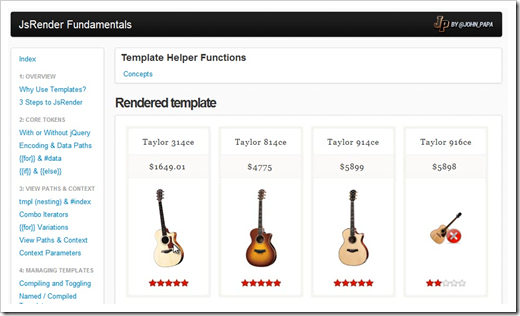Super fast rendering, code-less tag syntax, and no DOM nor jQuery dependency. That’s JsRender!
My latest course JsRender Fundamentals is now available at Pluralsight! Learn how to build fast, robust, and maintainable Web applications with JavaScript, jQuery and JsRender: the successor to jQuery Templates.
Free Preview:
Course Description:
JsRender (the successor to jQuery Templates) is a JavaScript library that allows you to define a boilerplate structure once and reuse it to generate content dynamically. Learn how JsRender brings a new templating library to HTML5 development that has a code-less tag syntax, high performance, no dependency on jQuery nor a DOM, supports creating custom functions, and uses pure string based rendering.
What are the modules?
> 1 minute teaser trailer on what the course covers
![]() 1: Getting Started with JsRender
1: Getting Started with JsRender
This first module sets the foundations for the course by showing you everything you need to know to get started with JsRender and some helpful resources. You'll also learn a few tips on some tools and conventions that may help you along the way.
This module introduces the core JsRender token syntax for HTML encoding, handling conditionals, expressions, and looping through data. Also covered are how to use JsRender without jQuery and the #data and #index tokens.
![]() 3: View Paths, Nesting and Context Changes
3: View Paths, Nesting and Context Changes
This module covers how to manage object hierarchies, changing context, view paths, and contextual parameters using the JsRender features.
This module covers important management and performance tips for your templates using JsRender and jQuery. You will learn how and when to use strings to store templates, how to compile and name 1 or more templates, and how to use external templates.
![]() 5: Advanced JsRender Concepts and Tips
5: Advanced JsRender Concepts and Tips
This module demonstrates how to create your own JsRender tags, converters and helper functions to create more powerful and cleaner templates through separation of behavior and structure. These tips can create powerful, resuable and more maintainable templates for web applications.
Demos:
The course includes 20+ demos that you can run (some within Visual Studio and others from JsFiddle)
Parting Thoughts:
I extend a sincere thank you to some great folks who helped influence this course through their contributions to open source, the plug in community, and some by helping me vet the content and ideas. They are, in no particular order:
- Boris Moore – creative mind behind of JsRender and jQuery Templates
- Hans Fjällemark – designed the responsive web design layout for the demos
- Ward Bell – helped vet my ideas for the “code concepts” window in the demos







